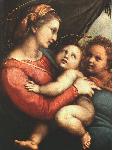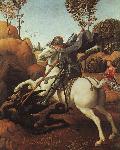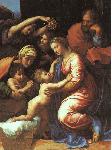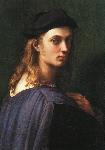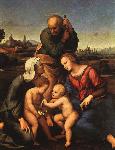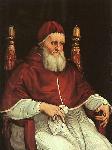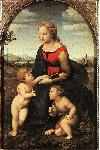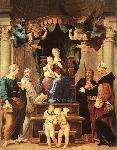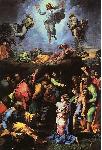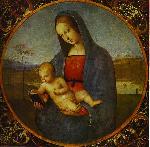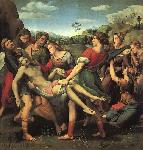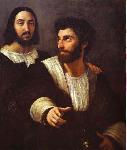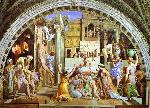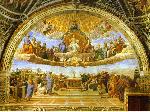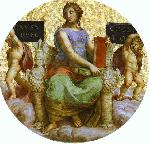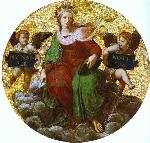Learn About Raphael in Art History, View His Art and Famous Paintings
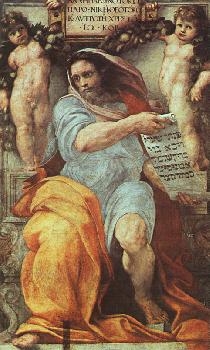
"The Prophet Isaiah”,Sanzio, 1511-12
Raphael Sanzio, 1483-1520, another of Italy’s famous artists in art history, was commissioned to paint the papal apartments in the Vatican. The first art theme was the four branches of human knowledge and wisdom. They are Philosophy, Law, Poetry and theology.
In 1509-11, Sanzio painted one of his most famous paintings School at Athens", representing the High Renaissance classical art structure of the ideal formal spatial harmony.
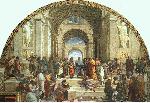
Sanzio’s subject of "School at Athens" is the Athenian school of thought. A group of famous Greek philosophers and scientists are gathered around Plato and Aristotle teaching and learning from each other. The composition is similar to that of Leonardo's "Last Supper", using a one point scientific three-dimensional perspective, with a frieze-like grouping of figures across the frontal picture plane.
His figure groupings are active and expressive reminiscent of Masaccio art and compositions. While commissioned to paint rooms in the Vatican, Raphael was able to see Michelangelo’s active Sistine figures in 1504, and therefore probably influenced creating his own three-dimensional figure space.
Raphael’s figures became bulkier with greater physical power and dramatic art expression. The lower central seated figure whose head is being held up with his arm is said to be Michelangelo.

Influenced by Leonardo da Vinci, Sanzio painted, Madonna del Granduca", in 1505 and “Madonna with the Goldfinch”, in 1505-06.
His figures are soft and supple using Leonardo's creation sfumato, the subtle gradation of lights and darks.
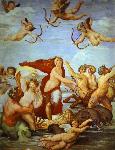
Sanzio maintained his own individual style in art however. His figures still full-bodied, active, and dynamic in the painting Galetea", 1513.The nymph Galatea is pursued in vain by Polyphemus, a theme taken from Classical Greek subject matter. Raphael’s composition is well balanced despite the very active figures. The eye flows around strategically placed bodies following outstretched arms in a circular motion leading back to the centrally placed Galetea.
The "Sistine Madonna", 1513, was one of the first paintings painted on canvas, originally intended to be hung over the coffin of Julius II.
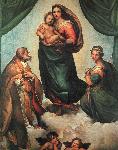 Julius is the sickly figure on the lower left anchoring the pyramidal art composition. His papal tiara rests below on his wooden coffin. Saint Barbara, the patron saint of the hour of death is on the right having been liberated from a tower seen in the distance behind the curtain. Mary walks through the parted curtains on clouds as if coming straight from heaven holding up the Christ Child with compassionate eyes.
Julius is the sickly figure on the lower left anchoring the pyramidal art composition. His papal tiara rests below on his wooden coffin. Saint Barbara, the patron saint of the hour of death is on the right having been liberated from a tower seen in the distance behind the curtain. Mary walks through the parted curtains on clouds as if coming straight from heaven holding up the Christ Child with compassionate eyes.
Raphael was a great portrait painter in art history as well. One of his famous paintings "Donna Velata", (veiled woman), 1513, seems to be the same person Raphael painted in the "Sistine Madonna".
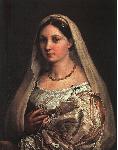 The colors used are influenced by Venetian art even though there are no records of him visiting Venice. An interesting comparison is Titians "Portrait of a Bearded Man", painted in 1510-15. Other artists of the Renaissance period are Jacapo Tintoretto and Sandro Botticelli.
The colors used are influenced by Venetian art even though there are no records of him visiting Venice. An interesting comparison is Titians "Portrait of a Bearded Man", painted in 1510-15. Other artists of the Renaissance period are Jacapo Tintoretto and Sandro Botticelli.
To view gallery 1 of Raphael posters click here.
To view gallery 2, Sanzio paintings, click here.
Click on the graphics below to increase graphic sizes. At the same you time can also view an opportunity to purchase a poster or painting reproduction.
